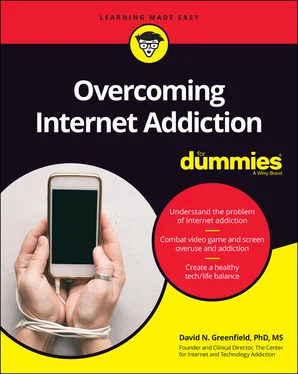Technology as a coping strategy
 If children or teens suffer from physical, mental, or emotional trauma, they may turn to addictive substances or behaviors as coping mechanisms — especially if they haven’t yet developed other coping strategies. Addiction to anything almost always starts as self-medication (or avoidance) to manage uncomfortable feelings or circumstances; ultimately, it starts out as a solution to a problem but then becomes a problem unto itself. Again, the Internet is not inherently the problem, but it’s a very powerful activity that can become a problem.
If children or teens suffer from physical, mental, or emotional trauma, they may turn to addictive substances or behaviors as coping mechanisms — especially if they haven’t yet developed other coping strategies. Addiction to anything almost always starts as self-medication (or avoidance) to manage uncomfortable feelings or circumstances; ultimately, it starts out as a solution to a problem but then becomes a problem unto itself. Again, the Internet is not inherently the problem, but it’s a very powerful activity that can become a problem.
Children of addicts may be more susceptible to developing addictions, and the addiction of choice may differ from that of the parent. For example, if the parent has an addiction to alcohol, the child or teen may develop an addiction to video games, gambling, or another behavior. The data on genetic influences on addiction seem to show some inheritability for general addiction, but even so, this only accounts for some of the reasons why addictions occur. The best thinking seems to point to addiction being a multi-causal problem with many variables involved and Internet and video game addiction is likely to be no different.
An intolerance of boredom
The growing intolerance of boredom is a significant factor for Internet addiction. While screen time may not always provide anything of great value, it can fill a void and provide an escape from the uninteresting moments in life. Many children, teens, tweens, and young adults are unable to sit for even a moment without reaching for their phone (this is probably true for many adults as well). When was the last time you waited in line at the post office or in a waiting room and didn’t pull out your phone? The ability to tolerate time without distraction has seriously eroded.
You may have noticed, in both yourself and your children, a growing intolerance of even a moment of doing nothing, and the easiest thing to do to escape that discomfort is to pick up your phone. However, these are moments that provide a potential opportunity to experience the spark of self-reflection or creativity, or the impetus for social connection. In short, not giving in to the urge to pick up the phone creates new neuropathways that give your child or teen an opportunity to sit with themselves for a moment and to be with themselves on a deeper level.
If your child’s attention span seems shorter than yours was as a child, this is not your imagination, as intolerance of boredom and impatience has become a significant side effect of screen and technology use. I’ve seen patients who can’t tolerate even two seconds without picking up their phone; their attention often seems to be elsewhere, and their patience and ability to delay gratification appear to be diminished. The net effect (pun again) of this pattern of endless screen use further serves to solidify addictive patterns and to weaken more positive self-management strategies.
 Boredom is necessary for achieving life balance. Screens can rob youth of the ability to tolerate the discomfort of boredom with the promise of something shinier and more attractive — but this occurs at a cost of endless distraction.
Boredom is necessary for achieving life balance. Screens can rob youth of the ability to tolerate the discomfort of boredom with the promise of something shinier and more attractive — but this occurs at a cost of endless distraction.
Chapter 4
Discovering What Makes the Internet and Smartphones So Addictive
IN THIS CHAPTER
 Recognizing how the Internet is easy to access and readily available
Recognizing how the Internet is easy to access and readily available
 Seeing that screen content has many addictive features
Seeing that screen content has many addictive features
 Understanding how the Internet is both a destination and a tool
Understanding how the Internet is both a destination and a tool
 Discovering how the Internet can be an addictive digital drug
Discovering how the Internet can be an addictive digital drug
The Internet is no longer new. When I started researching and treating Internet addiction, it was the mid- to late 1990s and the Internet was still the digital Wild West. Twenty-five years ago, few understood that this new, miraculous modality of communication and commerce could be addictive, but we did understand that it was very appealing.
My clinical and academic medical background is in addiction medicine; I was trained in the diagnosis and treatment of addiction, and I’ve also developed an expertise in sexual medicine and human sexuality — including compulsive sexual behavior. As the Internet burst across the globe, I began seeing patients who appeared to be having some difficulty with various aspects of their Internet use. Because the Internet was so new (and Wall Street was in love with its financial promise), most people did not see that all was not perfect in cyberspace.
In the early to mid-1990s, we were still using dial-up Internet that worked at a snail’s pace, but I still recall getting my first decent computer hooked up to the Internet and the welcome allure of those beeps and buzzes it made as our modem connected to the World Wide Web. I felt as if I were taking a trip somewhere and connecting to faraway people and places. It was exciting. Back then, online shopping and commerce were barely in their infancy; these were pre-Amazon days (if you can imagine that), and there wasn’t a lot happening online back then. But even before social media, Wi-Fi, smartphones, and high-speed Internet, you could feel how captivating this technology was.
In this chapter, you discover the common features and factors that make this technology so addictive. Although this problem is now largely accepted in the medical field, I want to offer what I’ve learned over the last 25 years of researching and treating it.
Eyes on the Prize: Factors Involving Focus on a Screen
Why do we like looking at our screens so much? It may seem intuitively obvious why video gaming is addictive. After all, it is stimulating, endlessly variable, rewarding (the fancy medical term is dopaminergic ), easily accessible — and fun. But in both my research and clinical practice, I find many areas of Internet screen use to be addictive as well. These include video platforms like YouTube, social media, video gaming, Reddit, online shopping, online gambling, information scrolling and surfing (kind of equivalent to TV channel surfing from the old days), and, of course, pornography. This section looks at the main reasons why people can’t help focusing on their screens.
Examining ease of access and near-constant availability
Ease of access has always been an enabling factor in addiction. In substance-based addictions, the availability of certain drugs or alcohol could often predict use, abuse, or relapse. With Internet and screen use, this is also a significant factor in that the Internet has become ever-present and easily accessible. Wi-Fi, high-speed Internet, smartphones, fast mobile service, tablets, and smart TVs have all brought the Internet to our fingertips. My prediction is that 5G (the next generation of mobile service networks) will only increase the addiction potential of the Internet and our devices, but especially the smartphone. The smartphone is essentially an always-on Internet portal that allows the Internet to be easily accessible, which I believe accounts for some of the Internet addiction cases over the last ten years.
Читать дальше

 If children or teens suffer from physical, mental, or emotional trauma, they may turn to addictive substances or behaviors as coping mechanisms — especially if they haven’t yet developed other coping strategies. Addiction to anything almost always starts as self-medication (or avoidance) to manage uncomfortable feelings or circumstances; ultimately, it starts out as a solution to a problem but then becomes a problem unto itself. Again, the Internet is not inherently the problem, but it’s a very powerful activity that can become a problem.
If children or teens suffer from physical, mental, or emotional trauma, they may turn to addictive substances or behaviors as coping mechanisms — especially if they haven’t yet developed other coping strategies. Addiction to anything almost always starts as self-medication (or avoidance) to manage uncomfortable feelings or circumstances; ultimately, it starts out as a solution to a problem but then becomes a problem unto itself. Again, the Internet is not inherently the problem, but it’s a very powerful activity that can become a problem. Boredom is necessary for achieving life balance. Screens can rob youth of the ability to tolerate the discomfort of boredom with the promise of something shinier and more attractive — but this occurs at a cost of endless distraction.
Boredom is necessary for achieving life balance. Screens can rob youth of the ability to tolerate the discomfort of boredom with the promise of something shinier and more attractive — but this occurs at a cost of endless distraction. Recognizing how the Internet is easy to access and readily available
Recognizing how the Internet is easy to access and readily available










